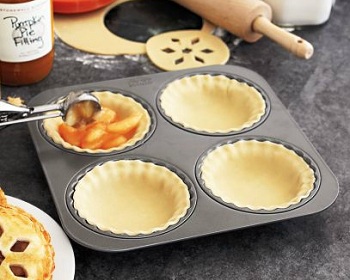
You might want to use a little extra caution the next time you pop a pyrex baking dish into the oven because Consumer Reports has noticed an uptick in the number of incidents involving exploding or unexpectedly shattering glass bakeware that have been reported recently. Not all of these incidents result in injury, but even if you don’t end up with a burn or a cut from a hot piece of glass, you could very well end up with an oven full of shards.
Pyrex and other glass bakeware is traditionally made of borosilicate, a type heat resistant glass that is fantastic for baking because it can easily withstand the high temperatures of the oven without breaking or cracking. This type of bakeware is even strong enough to hold up to sudden, sharp temperature changes. So why are some of them shattering unexpectedly when put into the oven or another high heat environment?
At some point, makers of glass bakeware, especially in the United States, switched from using borosilicate to using soda lime glass, which is less expensive to produce. Pyrex manufacturers in Europe still use borosilicate and any glass pans that you inherited from your parents or grandparents are made of borosilicate. Soda lime glass can more impact-resistant than borosilicate is, but it is not as resistant to heat or abrupt temperature changes as borosilicate is. Manufacturers World Kitchen and Anchor Hocking state that they put their soda lime glass through a thorough thermal tempering process to maximize its strength, but most of the reported incidents are from their products (not that surprising, since they produce about 75% of the glass bakeware in the US) and many of the incidents involved spontaneous breakage, rather than misuse or exposure to unusual conditions.
Consumer Reports put together a great video that shows the difference between borosilicate and soda lime glass. Glass bakeware is still safe to use, but if you have older pieces they are probably stronger and much less likely to shatter under normal use conditions.





Carol
September 13, 2011one bakeware glasses broke with cold temperature, i took out from the fridge and put it at my table, it wasn’t a sharp temperature change either. it just broke, and the other one broke in the sink no hit, nothing, it wans’t hot either, it was just water.
It’s cheap but not worthy.
Faythe
September 14, 2011WOW! I’m glad I read this today. I’ve been thinking about purchasing some glass bakeware for a few baking projects in the future, and wasn’t aware of the breakage issues. Thanks.
AC
September 15, 2011Thanks for the info! It’s sad that Pyrex decided to go the cheap route.
Sharlotte
September 15, 2011What was the timeframe of the switchover in glass type? 5 years ago? 10 years ago? I’m just wondering what I have so that I will handle it properly. Thanks for the post.
Kim K.
September 19, 2011Interesting to read this. We were hosting Easter brunch and had an exploding egg casserole. Of course the glass exploded all over everything else in the oven at the time. We now joke that brunches must be Pyrex free.
Karen
September 26, 2011Sad. Pyrex used to be a name one could trust for quality. I am sorry I just replaced my 9×13 glass dish – recent broken when I dropped it on a patio, but had it for almost 20 years…I bought another one thinking it would last me another “almost” 20 years as long as I don’t drop it on rocks, but maybe not. Nothing is created to last anymore. It’s very sad and makes one want to just use disposable stuff. It’s cheaper than paying for something meant to last and doesn’t….